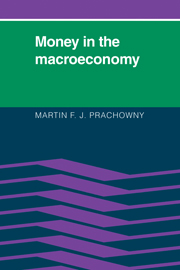Book contents
- Frontmatter
- Contents
- List of charts, figures, and tables
- Preface
- List of symbols
- 1 The roles of money and monetary policy in the macroeconomy
- 2 A model of the macroeconomy
- 3 The new classical model: the case against stabilization policy
- 4 The institutionalist model: the case for stabilization policy
- 5 The demand for money
- 6 The supply of money
- 7 The monetary mechanism
- 8 U.S. monetary policy and the dilemma of stagflation
- 9 A model of an open economy
- 10 Managed exchange rates and monetary policy
- 11 Monetary policy in Canada and its macroeconomic consequences
- 12 Improving the monetary policy apparatus
- Index
9 - A model of an open economy
Published online by Cambridge University Press: 26 October 2011
- Frontmatter
- Contents
- List of charts, figures, and tables
- Preface
- List of symbols
- 1 The roles of money and monetary policy in the macroeconomy
- 2 A model of the macroeconomy
- 3 The new classical model: the case against stabilization policy
- 4 The institutionalist model: the case for stabilization policy
- 5 The demand for money
- 6 The supply of money
- 7 The monetary mechanism
- 8 U.S. monetary policy and the dilemma of stagflation
- 9 A model of an open economy
- 10 Managed exchange rates and monetary policy
- 11 Monetary policy in Canada and its macroeconomic consequences
- 12 Improving the monetary policy apparatus
- Index
Summary
INTRODUCTION
The IS-LM-AS model has served us well so far in analyzing the recent macroeconomic experience in the United States. However, it is inappropriate to apply it in its current state to open economies such as Canada. We therefore need to make some adjustments to take into account the existence of international transactions, both in goods and in assets. Our main task in this chapter is to adapt the IS-LM-AS equations to an open economy. Once we have done that we can repeat some of our earlier experiments to compare how open economies react differently from closed economies when they are subjected to exogenous shocks and to compare the policy options that are available to the governments in these countries. First, we need to indicate the importance for Canada of international transactions compared to purely domestic trade.
There is no clear-cut method of classifying countries as closed economies or as open economies; there is really only a continuum of openness. Nevertheless, it is not unreasonable to think of the U.S. economy as being essentially closed with only 8.8% of its domestic output sold abroad in the form of exports of goods and services in the period 1976–80 and only 6.9% of its total expenditures going to foreign goods and services as imports. On the other hand, Canada exported 23.8% of its production during that same period and imported 27.5% of its needs.
- Type
- Chapter
- Information
- Money in the Macroeconomy , pp. 235 - 260Publisher: Cambridge University PressPrint publication year: 1986



